Basic AI Chatbot Pricing: A simple chatbot that can answer questions about a product or service might cost around $10,000 to develop.
Read More
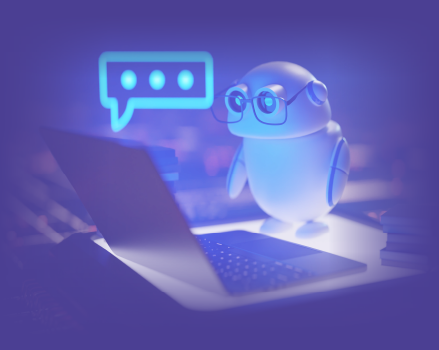
To give you a basic idea, the enterprise AI chatbot development cost can range between:
Basic Enterprise AI Chatbot Cost: A simple chatbot that can answer questions about a product or service might cost around $10,000 to develop.
Content Generation Chatbot Cost: A chatbot with the ability to generate personalized content and make reservations might cost around $50,000 to develop.
Enterprise Development Chatbot Cost: An AI chatbot that is customized to the specific needs of a business and integrated with third-party software might cost $100,000+ to develop.
Factors Influencing the Cost: The type of enterprise AI chatbot you want to build, the required functionalities, and training data primarily influence chatbot development cost.
The enterprise AI chatbot development cost depends on several factors — from the features and integrations you need to the development team’s expertise and the level of AI sophistication you choose. On average, the cost to build a chatbot for enterprises in 2025 can range anywhere from $50,000 to $120,000+, depending on the complexity, integrations, compliance needs, and scale of the solution.
Many companies wonder “how much does it cost to build a chatbot for enterprise?” or “how much does it cost to develop a chatbot for enterprise?” — and the truth is, the answer varies widely based on whether you choose enterprise chatbot platforms development or go for a custom enterprise chatbot platform development approach.
Spending excessively on a basic, pre-trained chatbot may not make sense when a well-planned solution can deliver the same or better ROI. The right development strategy can help you avoid overspending while still building a chatbot for enterprises that’s intelligent, scalable, and secure.
In this guide, we’ll break down the enterprise chatbot solutions cost, explore hidden expenses you should plan for, compare platform vs custom builds, and explain how businesses like yours can optimize enterprise AI chatbot development cost while still getting powerful results. But first, let’s understand what enterprise AI chatbots really are and why they matter for modern businesses
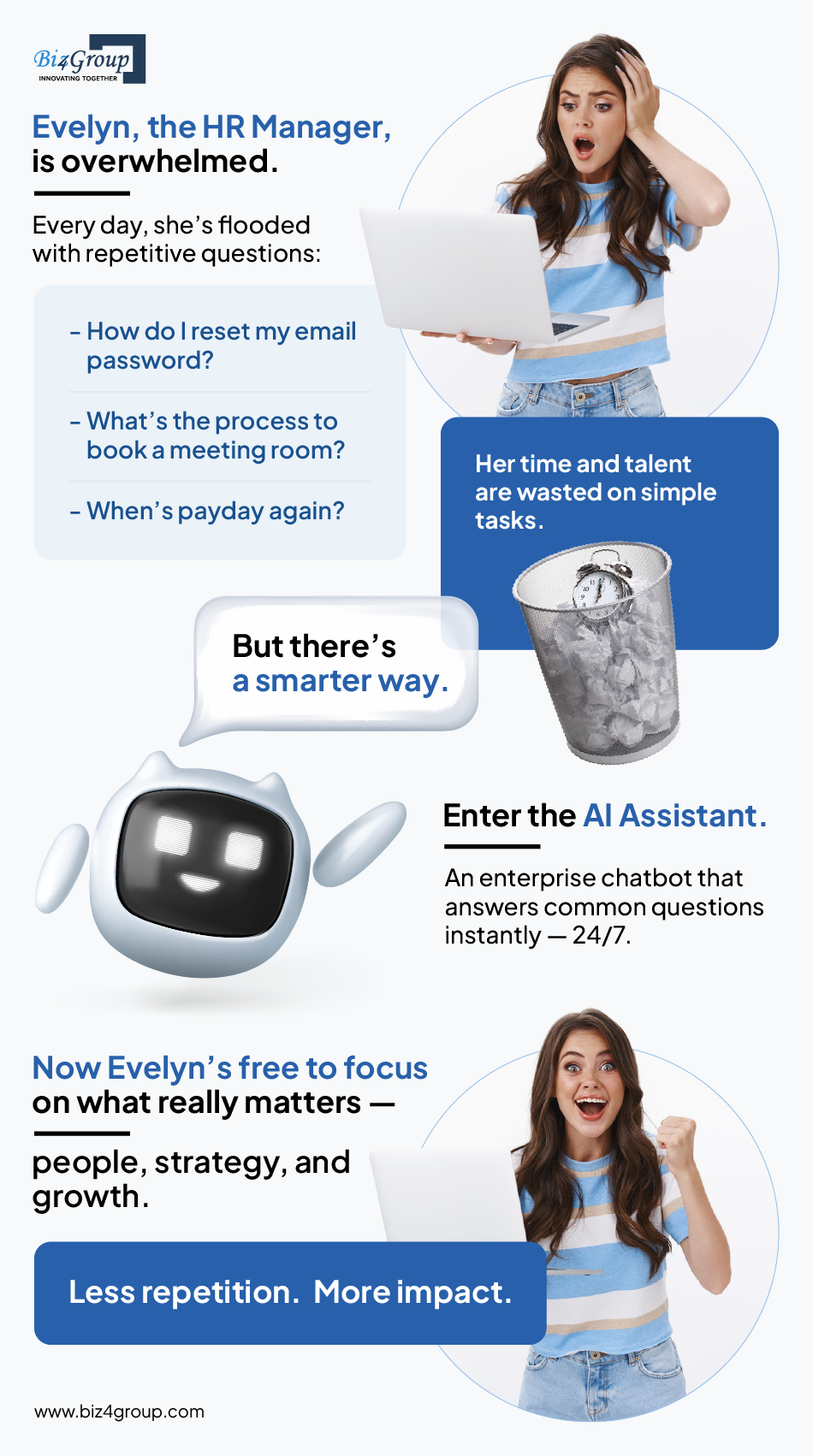
Enterprise AI chatbot solutions are advanced virtual assistants tailored specifically for large-scale organizations. Unlike standard chatbots that often serve basic functions like answering FAQs or providing generic support, enterprise chatbot solutions are designed to integrate deeply with a company’s internal systems, workflows, and data infrastructure.
These AI-powered chatbots go beyond surface-level conversations. They can handle complex queries, automate internal tasks, pull real-time data from enterprise systems like CRMs, ERPs, or HRMS, and even assist with onboarding, payroll queries, and IT troubleshooting.
Think of them as digital coworkers—always available, always learning.
Here is why enterprise AI chatbots differ:
In short, enterprise AI chatbot solutions empower companies to streamline operations, enhance employee productivity, and elevate the customer experience—all while reducing manual overhead.
Off-the-shelf bots can’t match your business complexity.
Let’s Build a Tailored AI AssistantThe cost to develop enterprise AI solutions depends on several factors such as the type of chatbot, the required features and scale, the area of implementation, implementation strategy, and more.
Let’s discuss the factors that affect the enterprise AI chatbot development cost:
Modern enterprise chatbots are commonly linked with AI technology, which enables them to handle inquiries without human intervention. Legacy chatbots that follow predefined scripts and utilize decision tree structures may suffice for basic FAQ queries but struggle to meet the demands of enterprises.
When considering enterprise AI chatbot development services, you have five main AI chatbot options to choose from. The cost to build each of them differs from the other where the first one costs the least and the fifth one costs the most:
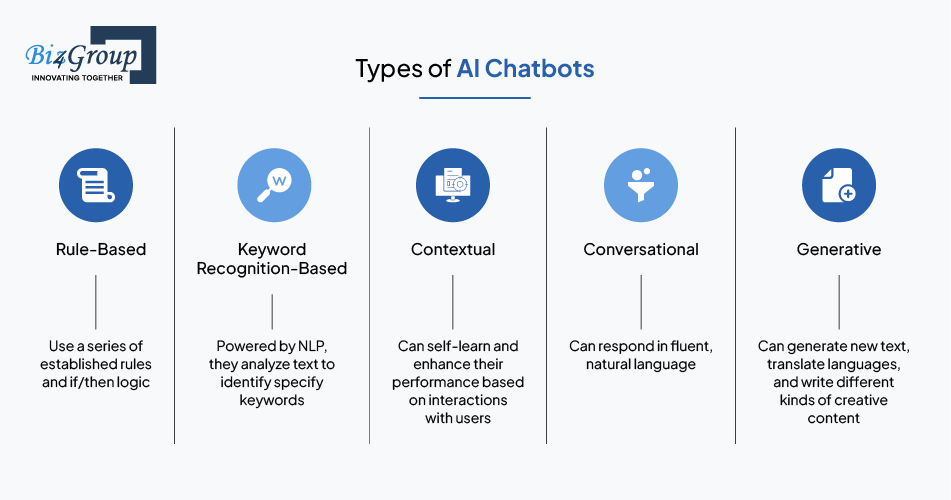
Cost to build Rule-Based Chatbots: $8,000 – $15,000
These chatbots construct conversational paths using a series of established rules and if/then logic. Once you define the parameters for your chatbot (such as facts, rules, query types, words, and synonyms), it can quickly provide answers. However, rule-based enterprise chatbots falter when faced with queries that deviate from their trained scenarios and cannot adapt through interactions.
Cost to develop Keyword Recognition-Based Chatbots: $12,000 – $20,000
Enabled by natural language processing (NLP), these AI-driven chatbots can aptly respond by analyzing text to identify specific keywords from free-form input. This approach offers users greater flexibility and a more natural conversational experience.
Nevertheless, AI-driven chatbots, particularly those based on keyword recognition, struggle when a query contains an abundance of keywords pertaining to diverse questions. To guide the conversation, companies often utilize a combination of menu-based and keyword recognition-based enterprise chatbot solutions.
Cost to create Contextual Chatbots: $20,000 – $40,000
Supported by ML and AI, contextual chatbots possess the ability to self-learn and enhance their performance based on interactions with users. These chatbots retain memories of past conversations and can refine their responses through deep learning. These enterprise chatbot solutions can address a wide range of customer inquiries, including tasks like food ordering, ticket booking, and support for supply chain operations.
Cost of Conversational AI Chatbots development: $30,000 – $60,000
These bots rely on deep learning, NLU, and NLP to capture, interpret, and analyze users' voice commands. We’re way past robotic voices; conversational chatbots respond in fluent, natural language. Similar to other contextual chatbots, conversational AI chatbots can learn from their interactions, and you can train them with industry-specific scenarios to better understand your audience's requests.
Development cost of Generative AI Chatbots: $30,000 – $120,000
Gone are the days of chatbots that can only respond to pre-programmed questions. Generative AI development services enable chatbots to generate new text, translate languages, write different kinds of creative content, and answer your questions in an informative way. Similar to other conversational chatbots, these chatbots can learn from their interactions, and you can train them with industry-specific data to better understand your audience's needs.
If you wonder how Generative AI Chatbots are different than Conversational ones, here are the differentiating pointers:
Let’s know the cost of each type of enterprise chatbot solutions:
|
Type of Chatbot |
Estimated Development Cost |
|
Rule-Based Chatbots |
$8,000 – $15,000 |
|
Keyword Recognition-Based Chatbots |
$12,000 – $20,000 |
|
Contextual Chatbots |
$20,000 – $40,000 |
|
Conversational AI Chatbots |
$30,000 – $60,000 |
|
Generative AI Chatbots |
$30,000 – $120,000 |
We’ve recently built a similar AI chatbot for one of our clients. You can check the case study on this here: Dr. Truman AI Avatar Case Study
Biz4Group ensures precise chatbot training data sourcing and labeling, so your enterprise AI chatbot answers users intelligently and reliably.
Let’s Train Your Bot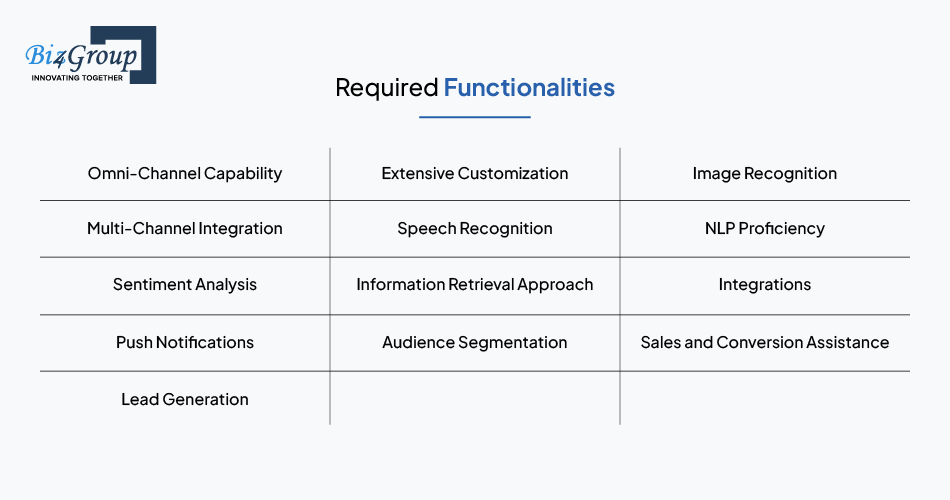
A remarkable chatbot encompasses a blend of attributes that contribute to its excellence. These features are pivotal for enhancing your business's performance:
Cost to build a chatbot with omni-channel capability: $5,000–$10,000
An AI-infused chatbot that operates seamlessly across devices and communication channels guarantees a unified and smooth user experience. By centralizing customer data from diverse channels, you can eliminate redundancy and provide consistent user support.
This feature significantly enhances customer satisfaction and is a non-negotiable in modern enterprise AI chatbot solutions.
Estimated cost for customization features: $4,000–$8,000
The ability to extensively customize your chatbot empowers you to mirror your company's identity and values. This is achieved through tailored conversation flows and contextualized interactions with customers. The chatbot's proficiency in understanding natural language, including regional nuances, as well as incorporating emojis, gifs, and images, fosters this personalized experience.
Highly customized bots may also require unique chatbot training data, influencing overall chatbot training data pricing.
Added cost: $7,000–$15,000
Equipping your chatbot with image recognition capabilities enables it to identify objects within images, respond to inquiries, and engage in meaningful discussions about customer-uploaded images using advanced deep learning techniques.
It’s a premium feature that adds innovation and interactivity to your enterprise chatbot solutions.
Cost to implement multi-channel integration: $5,000–$12,000
Seamlessly integrating your chatbot into various messaging platforms frequented by your customers streamlines information flow to a single channel for your team, ensuring efficient communication.
This feature ensures your enterprise ai chatbot becomes a cohesive part of your communication ecosystem.
Estimated implementation cost: $6,000–$10,000
Speech recognition transforms voice input into actionable text, ideal for mobile-first users and accessibility-friendly interfaces. It’s a critical step toward building voice-enabled enterprise AI chatbot solutions.
Combining this with NLP can further raise the bar on user experience—and the overall enterprise ai chatbot development service cost.
NLP implementation cost: $8,000–$20,000
Natural Language Processing (NLP) prowess enables your chatbot to comprehend and analyze human inputs, facilitating fluid and effective conversations. NLP also enables continuous learning from every interaction.
This feature is foundational to any enterprise ai chatbot that aims to offer smart, human-like interactions.
Cost estimate: $5,000–$10,000
A subset of NLP, sentiment analysis, aids in identifying and gauging emotions, leading to an improved understanding of conversation tone. Based on this sentiment, your chatbot tailors responses to suit the emotional context.
For customer service-focused enterprise chatbot solutions, this is especially beneficial.
Cost to build this feature: $5,000–$10,000
Employing an information retrieval approach equips your chatbot to offer human-like responses autonomously. It categorizes user queries, matches them with database entries, and delivers relevant answers using pre-stored or trained options.
This function also benefits from high-quality chatbot training data, contributing to chatbot training data pricing.
Typical cost per integration: $3,000–$10,000
Seamless integrations with various data sources, such as custom services, business applications, and third-party apps like Salesforce, Slack, Zoho CRM, Mailchimp, Zendesk, and Google Sheets, empower your chatbot to collect data, automate tasks, and enhance efficiency. For this, you need to consider availing AI integration services.
A robust enterprise ai chatbot development service ensures these integrations are seamless and secure.
Add-on cost: $2,000–$5,000
Utilizing push notifications enables your chatbot to re-engage users, sharing updates, reminders, insights, and promotional messages, fostering ongoing user engagement.
This lightweight feature adds immense value to your enterprise chatbot solution without overloading the budget.
Cost to implement segmentation: $3,000–$7,000
By gathering pertinent details, your chatbot segments the audience into distinct categories, facilitating personalized interactions and tailored responses.
Incorporating this feature makes your enterprise ai chatbot smarter and more strategic in nurturing leads.
Cost range: $5,000–$10,000
AI chatbots possess the ability to guide customers through pricing inquiries, product recommendations, and appointment bookings, ultimately improving conversion rates and customer engagement.
This feature adds an ROI-driven edge to enterprise chatbot solutions, directly impacting revenue generation.
Biz4Group's conversational AI and generative AI chatbots are trained to manage layered, high-stakes conversations with precision.
Contact UsImplementation cost: $4,000–$8,000
Chatbots play a vital role in capturing high-quality leads by initiating interest through contextually relevant questions.
If you’re exploring how much does it cost to develop a chatbot, this feature is among the most ROI-positive investments.
Overall, the more sophisticated the functionalities, the higher the investment. Here's a general estimate per feature:
|
Feature |
Additional Cost |
|
Omni-Channel Capability |
+$5,000 – $10,000 |
|
Extensive Customization |
+$4,000 – $8,000 |
|
Image Recognition |
+$7,000 – $15,000 |
|
Multi-Channel Integration |
+$5,000 – $12,000 |
|
Speech Recognition |
+$6,000 – $10,000 |
|
NLP Proficiency |
+$8,000 – $20,000 |
|
Sentiment Analysis |
+$5,000 – $10,000 |
|
Information Retrieval Approach |
+$5,000 – $10,000 |
|
Third-Party Integrations (CRM, etc.) |
+$3,000 – $10,000 per integration |
|
Push Notifications |
+$2,000 – $5,000 |
|
Audience Segmentation |
+$3,000 – $7,000 |
|
Sales and Conversion Assistance |
+$5,000 – $10,000 |
|
Lead Generation Features |
+$4,000 – $8,000 |
While not all these features are obligatory, selecting the right combination can be challenging. An experienced AI development company can assist in crafting a customized enterprise chatbot tailored to your specific business needs.
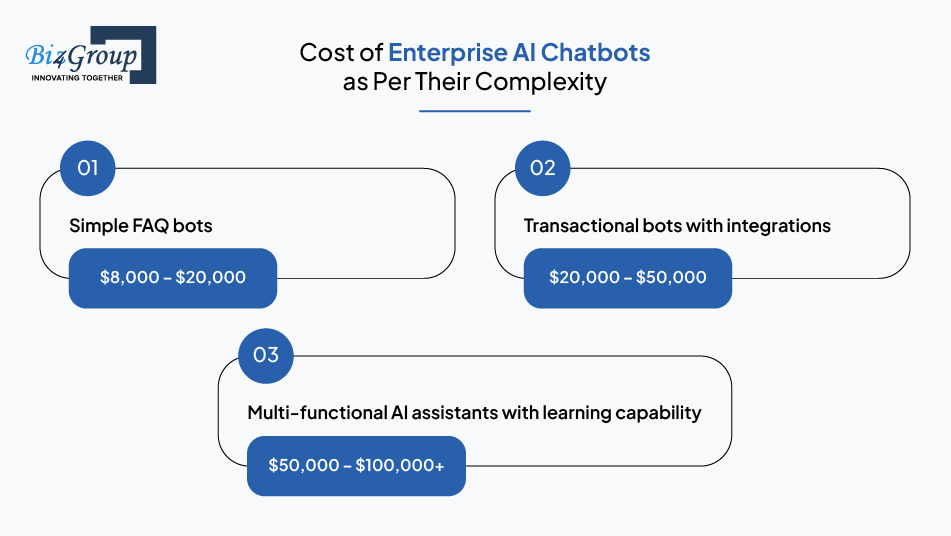
The complexity of a chatbot contributes significantly to the enterprise chatbot pricing. It can be measured by the following factors:
A more complex chatbot will require more time and effort to develop and will therefore be more expensive.
For example, a chatbot that can understand and respond to a wide range of user queries, that can generate personalized content, make reservations, and handle customer service inquiries, and that is customized to the specific needs of a business would be very complex. As a result, the cost to develop such AI chatbot would be correspondingly high.
Overall, here is the cost of enterprise AI chatbot development as per their complexity:
The more your chatbot learns, adapts, and integrates into business operations, the more time and resources it requires.
Our proven enterprise AI chatbot development service uses strategic roadmapping to get it right—the first time.
Start with a PoCThe expertise of the developers who are working on the chatbot can also affect its cost. Experienced developers can work more efficiently and produce higher-quality code. As a result, they tend to charge more for their services.
The cost to hire AI developers will vary depending on their location and their level of expertise. For example, developers in the United States will typically charge more than developers in Asia and some parts of Europe.
Here are some rough estimates on the hourly rates of developers:
|
Developer Region |
Hourly Rate |
|
United States/Canada |
$80 – $150/hr |
|
Western Europe |
$70 – $120/hr |
|
Eastern Europe |
$40 – $80/hr |
|
India/Southeast Asia |
$25 – $60/hr |
Although it’ll seem enticing to hire developers from India or Southeast Asia to reduce cost of development, it’s mindful not to compromise with the quality of development. Developing an enterprise AI chatbot requires a high standard of data security, reliability, and scalability. Hence, the best option for US companies and entrepreneurs is to consider consulting an AI agent development company that has experience in building AI solutions for enterprises.
The time to market is also a factor that can affect the cost of AI chatbot development. If a business needs to deploy a chatbot quickly, it will have to pay more for expedited development. This is because developers will need to work longer hours and may need to hire additional help.
Faster delivery requires additional staffing, overtime, and streamlined workflows, which increase costs.
Once a chatbot is deployed, it will need to be maintained and supported on an ongoing basis. This includes fixing bugs, adding new features, and adapting the chatbot to changes in the business environment. The cost of maintenance and support can be significant, especially for complex chatbots.
|
Maintenance Service |
Annual Cost |
|
Basic Support (bug fixes, minor updates) |
$5,000 – $10,000/year |
|
Comprehensive Support (feature upgrades, retraining models) |
$10,000 – $25,000/year |
The cost of training data can also affect the cost of chatbot development. If a chatbot is trained on a large dataset of text and code, the cost of training data will be higher. This is because it can be expensive to gather and label a large dataset; you’ll require to adopt an AI development platform that can handle a massive amount of data and process it.
|
Dataset Size |
Data Preparation Cost |
|
Small Dataset (up to 100,000 records) |
$3,000 – $8,000 |
|
Medium Dataset (100,000 to 500,000 records) |
$8,000 – $20,000 |
|
Large Dataset (1M+ records) |
$20,000 – $50,000+ |
Overall, the chatbot development cost in an enterprise scenario will vary case by case. If you want to get an exact estimate for your enterprise chatbot development cost, get in touch with Biz4Group’s AI chatbot experts.
If you’re wondering “how much does it cost to build a chatbot for enterprise?” or “how much does it cost to develop a chatbot for enterprise?”, the **average enterprise AI chatbot cost in 2026 ranges between $50,000 and $120,000+, depending on complexity, integrations, and AI capabilities. Below is a phase-wise breakdown of costs and timeline to help you plan your investment effectively.
Why it matters: This stage defines your chatbot’s scope and sets realistic budget expectations.
Pro Tip: Investing in strong design early helps reduce costly revisions later.
Key factor: Advanced AI models increase both accuracy and overall enterprise AI chatbot cost.
Note: Complex enterprise integrations often drive costs upward.
The cost of enterprise AI chatbot development varies significantly depending on the industry, use case, and complexity of integrations. Here’s a breakdown of estimated costs for common enterprise scenarios, with examples from Biz4Group’s real-world chatbot projects.
When estimating enterprise AI chatbot cost, many companies focus only on development hours and initial feature sets. However, there are hidden costs — often adding 20–40% to the total project budget — that can catch teams off guard if not planned for early. Understanding these factors helps you budget more accurately and avoid unexpected overruns.
Before training an AI chatbot, enterprise data must be collected, cleaned, and structured. Complex data sources, outdated records, or siloed systems can drive up costs for data engineering and annotation.
Initial model development is just the start. Fine-tuning on domain-specific data and regular re-training to improve accuracy add recurring expenses.
Many chatbots rely on NLP platforms, cloud services, or third-party APIs (like GPT models, analytics, or payment gateways). These costs often scale with usage and can become significant as adoption grows.
Enterprises often need HIPAA, GDPR, SOC-2, or ISO compliance. Building extra layers of encryption, access control, and audit logging can increase cost and timeline.
Linking the chatbot with ERP, CRM, HR, or proprietary systems can require custom connectors or middleware, especially if legacy infrastructure is involved.
To handle large traffic volumes, enterprises may need load balancing, container orchestration, or multi-region deployments — all of which increase hosting and DevOps costs.
Real-time monitoring, analytics dashboards, performance optimization, and continuous support often add ongoing monthly costs not accounted for in the initial build.
Building a chatbot for enterprises can become expensive if the project isn’t carefully planned. While the enterprise AI chatbot development cost can range from $50K to well over $120K, smart planning and the right choices can help you control spending without sacrificing performance or scalability. Here’s how to keep your enterprise chatbot solutions cost under control:
Start with a minimum viable product (MVP) that focuses on high-impact use cases (e.g., customer support, HR self-service, IT helpdesk). Avoid overloading your first release with complex features that inflate the enterprise chatbot platforms development cost.
Using pre-trained NLP models or platforms like GPT, Dialogflow, or Rasa can reduce both development time and cost. Custom fine-tuning is cheaper than building models from scratch.
Clean, structured, and well-labeled data reduces delays and rework. Investing early in data preparation can lower training and maintenance costs later.
Integrate with only the most critical systems first (CRM, ERP, ticketing). Overly complex integrations drive up enterprise chatbot solutions cost.
Building compliance and security features upfront is cheaper than retrofitting them later. This approach helps avoid unexpected jumps in enterprise AI chatbot development cost.
Break the project into sprints, test frequently, and refine. Agile workflows help catch issues early and avoid expensive fixes during full deployment.
Deploying on scalable cloud infrastructure helps manage hosting costs and ensures you pay for resources only when needed.
At Biz4Group, we know that enterprise AI chatbot development cost isn’t just about coding — it’s about smart planning, technology choices, and long-term scalability. Our proven process helps enterprises reduce development expenses by up to 30–40% while delivering robust, future-ready chatbot solutions.
We begin by deeply understanding your workflows, customer touchpoints, and success metrics. This allows us to design a lean, high-impact chatbot for enterprises that focuses on priority use cases and avoids over-engineering.
Our experts evaluate whether enterprise chatbot platforms development or custom AI models will deliver better ROI for your use case. By leveraging pre-trained NLP models where possible and fine-tuning only when needed, we keep costs predictable and avoid unnecessary complexity.
Seamless integration with CRMs, ERPs, HR, and IT systems is crucial — but can easily inflate costs. We use modular and API-first approaches to reduce integration complexity and avoid long-term technical debt.
Instead of adding costly compliance fixes later, we bake in GDPR, HIPAA, SOC-2, and enterprise-grade security from the start. This lowers risk and prevents expensive rework.
Our agile sprints allow you to see progress early, validate features quickly, and pivot before costs spiral. This also speeds up time to market while keeping budgets under control.
Biz4Group doesn’t stop at deployment. We offer ongoing monitoring, model retraining, and performance tuning to ensure your chatbot remains cost-efficient as user needs grow.
We’ll help you plan, build, and scale a chatbot that delivers real ROI — without breaking your budget.
Let’s TalkWhy Choose Biz4Group?
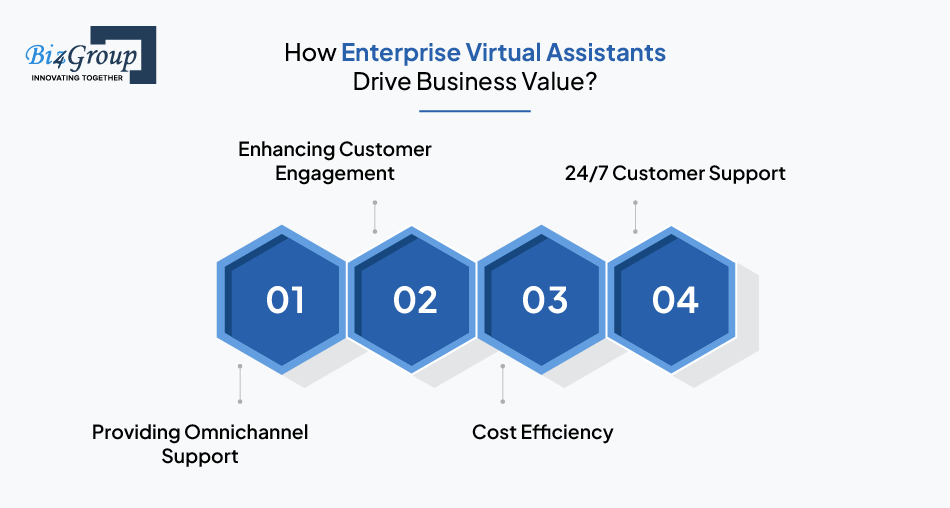
Developing enterprise AI assistants can assist companies in streamlining business processes and scaling rapidly.
An AI-powered chatbot can aid your employees in prioritizing tasks, scheduling meetings, composing reports, and managing routine assignments. Let’s explore the key advantages:
Two-thirds of consumers express their greatest frustration in customer service as the need to repeatedly explain the same information - HubSpot. AI-driven chatbots retain records of every interaction across diverse communication channels, ensuring consistent user support.
Chatbots possess the intelligence to analyze customer information and past inquiries, facilitating swift and meaningful conversations. A report by Statista demonstrates that one-third of consumers are highly content with the service provided by chatbots. Additionally, the same study reveals that only one in ten consumers is dissatisfied with their interactions with a chatbot.
Chatbots can handle numerous mundane, repetitive tasks such as processing insurance claims or generating invoices. They significantly reduce the time your staff dedicates to addressing customer queries, allowing them to concentrate on high-value customer interactions.
We build enterprise AI chatbots that self-learn, adapt to new queries, and continuously improve their accuracy using dynamic ML retraining models.
Future-Proof Your ChatbotIn the contemporary business landscape, speed and convenience are of utmost importance. A substantial majority (two-thirds) of customers anticipate rapid query resolution, with 40% expecting round-the-clock customer service. Thankfully, chatbots are capable of fulfilling this demand.
What we’ve mentioned is only a portion of the reasons why adopting an enterprise AI assistant can confer a competitive edge upon your company. Nonetheless, not all chatbots are equally proficient in specific tasks. Therefore, let's delve into the diverse types of enterprise chatbots and the respective purposes they can serve.
At Biz4Group, we’ve had the privilege of designing and developing enterprise AI chatbot solutions that have streamlined operations, improved customer experiences, and elevated business intelligence for our clients. Here's a glimpse into some of our top projects by our enterprise chatbot development company:
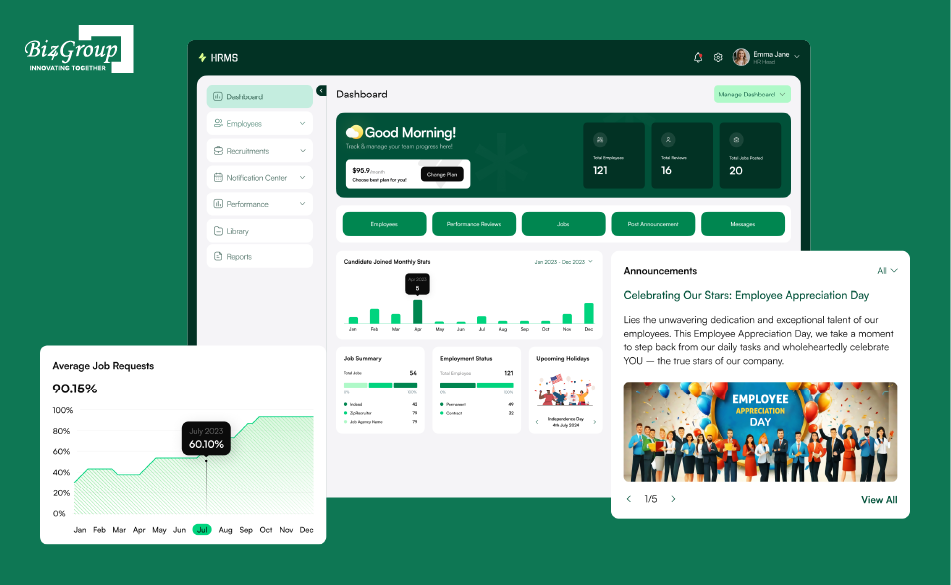
DrHR is a comprehensive AI-driven HRMS platform that integrates an enterprise chatbot solution to automate employee management, resolve HR-related queries, and enhance internal communication.
Key Features:
Chatbot Role:
The chatbot acts as a virtual HR assistant, reducing manual intervention and offering round-the-clock support to employees.
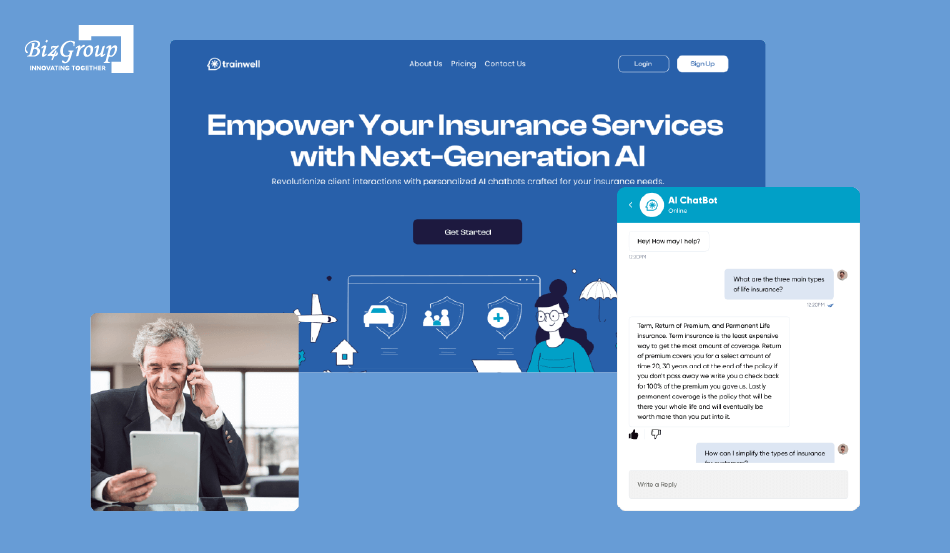
Insurance AI leverages an advanced enterprise AI chatbot that assists insurance agents with real-time training, certification tracking, and knowledge base management.
Key Features:
Chatbot Role:
By providing quick, reliable answers and automating repetitive inquiries, the chatbot enhances productivity and accelerates learning curves within insurance agencies.
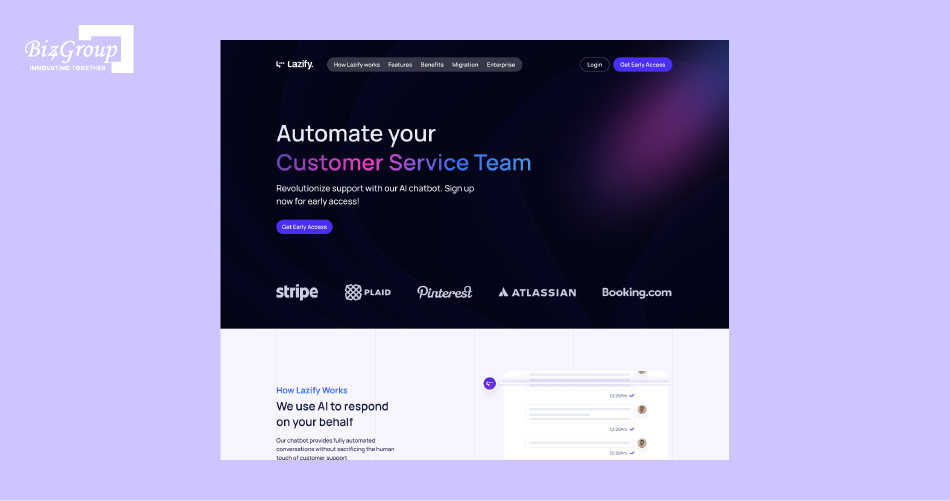
Designed to create human-like customer communication, this enterprise chatbot solution enhances customer engagement through natural language understanding and smart conversation handling.
Key Features:
Chatbot Role:
AI-Powered Chatbot for Human-Like Customer Support facilitates real-time, intuitive, and personalized support, significantly reducing support ticket volumes and response times.
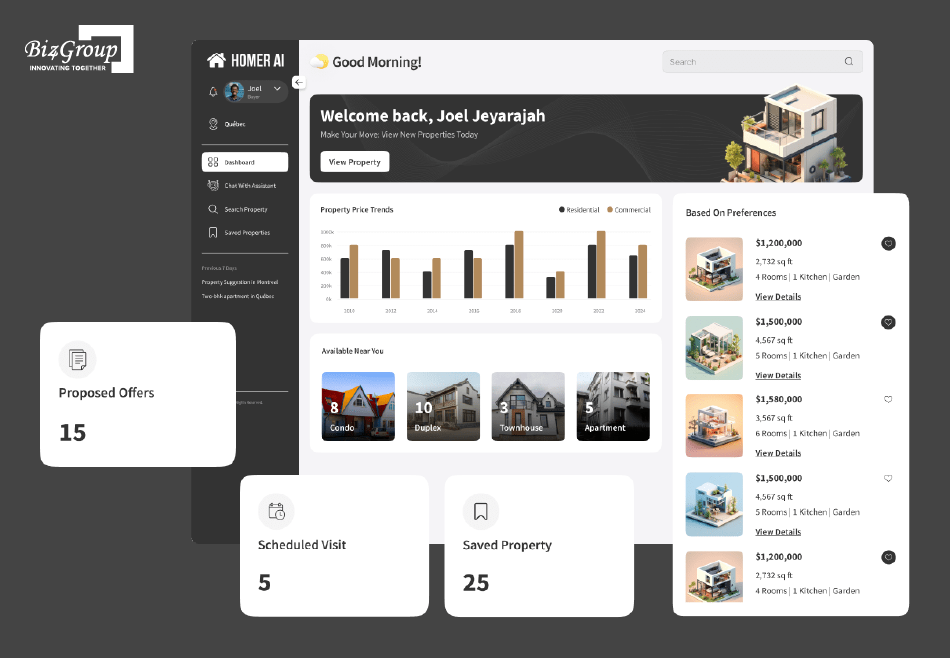
Homer AI offers a smart property management solution that incorporates chatbot capabilities to manage tenant interactions, maintenance requests, and property listings.
Key Features:
Chatbot Role:
The chatbot streamlines communication between property managers and tenants, ensuring faster resolution and an enhanced user experience.
Biz4Group’s enterprise chatbot solutions are built with robust encryption, access control, and compliance standards like HIPAA, GDPR, and SOC2.
Secure Your AI SolutionWhen considering enterprise chatbot platforms development, one of the first decisions enterprises face is whether to build a custom chatbot solution from scratch or buy and adapt an existing platform. This choice has a major impact on functionality, scalability, and the overall cost to build a chatbot.
Best for:
Advantages:
Limitations:
Best for:
Advantages:
Limitations:
| Approach | Average Upfront Cost | Typical Timeline | Ongoing Costs |
|---|---|---|---|
|
Platform (Buy) |
$30K – $80K |
1–3 months |
Subscription / API usage |
|
Custom (Build) |
$80K – $150K+ |
6–12+ months |
Maintenance, hosting, retraining |
We’ll guide you to the smartest choice — and build a chatbot that fits your enterprise perfectly.
Let’s TalkYou can’t just jump on the ship of AI and build the AI assistants the world has ever seen. You need to experience the tests and failures in order to build the best chatbots.
We, at Biz4Group have been building AI chatbots since 2014 when the language models became popular. We’ve been an active participant in the growth of conversational AI and now, the generative one as well. Even recently, we’ve helped businesses in the United States with our AI consulting services.
Hence, if your organization is planning to adopt AI virtual assistants or wants to build an assistant for other businesses out there, look no further than us.
Enterprise chatbot solutions are AI-powered virtual assistants designed to automate complex business tasks, integrate with enterprise systems like CRM and ERP, and handle large-scale internal or external communications. Unlike basic chatbots, enterprise chatbot solutions focus on scalability, security, and deep system integration to drive operational efficiency.
The cost to develop a chatbot can range between $10,000 and $100,000+, depending on factors like the chatbot's complexity, integration needs, functionalities, and the development team's expertise. Simpler FAQ bots are more affordable, while fully customized enterprise AI chatbot solutions cost significantly more.
An enterprise AI chatbot solution is a sophisticated AI-driven platform that serves large businesses by automating workflows, supporting customer service, enabling internal communication, and providing actionable insights. These bots leverage NLP, ML, and deep learning to offer personalized and efficient interactions across channels.
Several factors affect the cost to build a chatbot, including the type of chatbot (rule-based, contextual, conversational AI, or generative AI), required features (like NLP, multi-channel support, image recognition), integration complexity, training data requirements, and the expertise of the development team.
Training data pricing can significantly impact development costs. Higher-quality and larger datasets increase chatbot accuracy but also add to the initial investment. For small datasets, data preparation may cost around $3,000–$8,000, while large datasets can exceed $50,000 depending on complexity and domain specificity.
An enterprise AI chatbot enhances employee productivity, improves customer experience, ensures 24/7 service availability, and reduces operational costs. By automating routine tasks and offering intelligent insights, these chatbots free up human resources to focus on strategic, high-value initiatives.
An enterprise AI chatbot development service typically includes chatbot consulting, requirement analysis, custom chatbot design and development, AI training (NLP, ML integration), third-party system integration (like CRMs, HRMS), chatbot testing, deployment, and ongoing support and maintenance.
Enterprise AI chatbot solutions drive business value by automating repetitive tasks, improving customer engagement, accelerating decision-making with real-time data access, and scaling business operations efficiently. They offer measurable ROI by reducing manual workload and enhancing customer satisfaction.
with Biz4Group today!
Our website require some cookies to function properly. Read our privacy policy to know more.